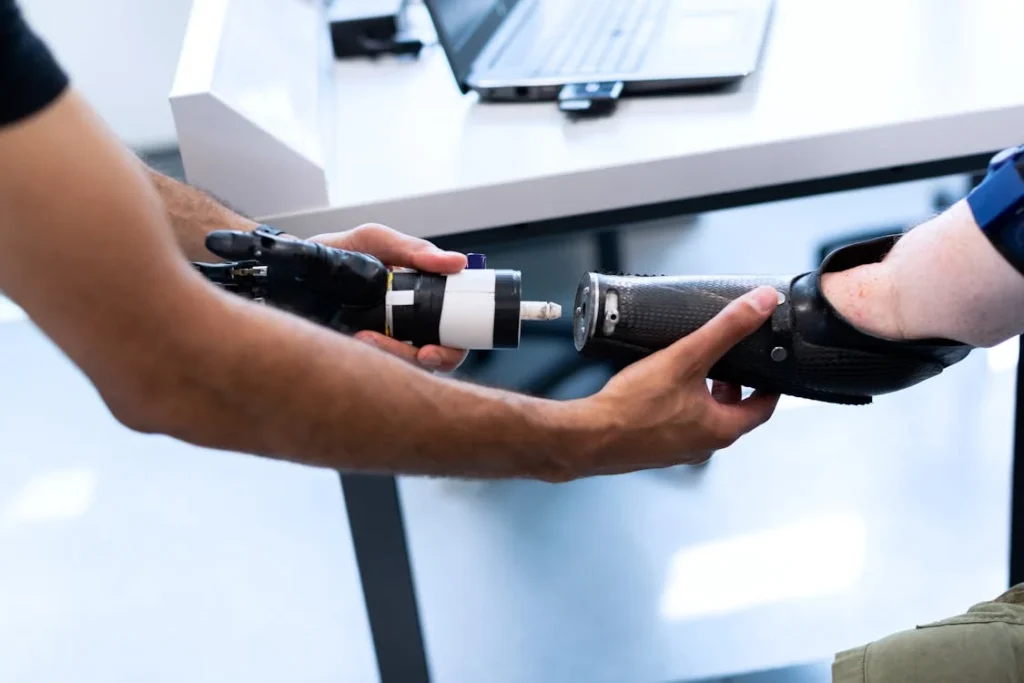For children using prosthetics, therapy is a big part of their journey. It helps them get used to their new limb and learn how to move, grip, walk, or play just like they did before. But let’s be honest—therapy is hard. And when you’re a child, sitting through boring, repetitive exercises is the last thing you want to do.
That’s where gamified therapy comes in.
Instead of boring drills, kids get to play games that are designed to build strength, coordination, and confidence. These games aren’t just fun—they’re smart. They’re based on how children learn best: through exploration, rewards, movement, and play.
At Robobionics, we believe that combining high-tech prosthetics with playful, interactive therapy is the future. Gamified therapy doesn’t just keep kids engaged—it transforms their whole experience, helping them heal faster and feel empowered every step of the way.
Now let’s dive deep into why this method is changing lives.
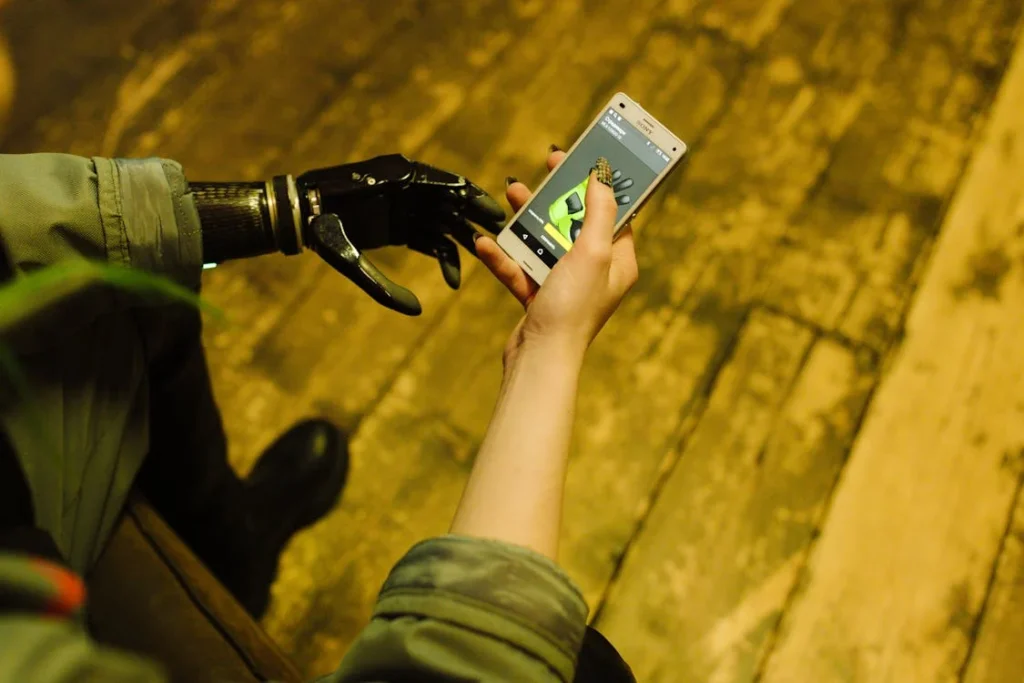
What Is Gamified Therapy and Why Does It Matter for Kids with Prosthetics?
The Shift from Repetition to Motivation
Traditional therapy often involves doing the same movement over and over again. A therapist might ask a child to reach forward 10 times, then grasp a ball, then move their arm side to side. These actions are important for building control, but they can feel dull and tiring for a child—especially one who’s also coping with the emotional stress of limb loss or difference.
Gamified therapy flips this model on its head.
Instead of repeating a task because they have to, kids repeat movements because they want to. Whether they’re guiding a dragon through a maze by opening and closing their bionic hand, or popping balloons by raising their arm, every motion has a clear, exciting goal.
There’s feedback—points, sounds, animations—that makes their brain light up. Each small success keeps them hooked, encouraging them to try again and again.
The Science of Play: Why Games Work So Well for Children
Children learn differently than adults. They absorb skills best when they’re relaxed, happy, and curious. When therapy becomes a game, it turns into a challenge rather than a chore. Instead of focusing on pain or struggle, the child focuses on scoring points or unlocking a new level.
This emotional shift makes a huge difference in results. Research shows that children in gamified therapy are more likely to complete their sessions, stick to their routine, and show faster improvement in limb function. That’s because games stimulate areas of the brain connected to reward, memory, and motor learning—all essential for mastering a prosthesis.
Also, games often give kids something they may have lost after amputation: a sense of control.
Using a prosthetic limb can feel strange at first. It may move slowly, or not respond the way they expect. But with a game, they can see their progress in real time. If they move their hand, the game character jumps. If they rotate their arm, a spaceship turns. That instant connection between action and reward builds confidence.
The Emotional Side: Confidence, Belonging, and Joy
Beyond the physical benefits, gamified therapy helps children emotionally. After losing a limb, some kids may feel different or left out. They might avoid physical play or become withdrawn. But when they enter a game world where their prosthetic gives them power—where they can win, compete, or even lead—they start seeing their limb as a strength, not a limitation.
Some therapy platforms even let kids customize avatars that look like them, prosthetic and all. Seeing themselves represented in the game helps them feel seen and included. In some cases, it even sparks friendships between kids who are on similar journeys.
And for parents? It’s a gamechanger too. Watching your child laugh, move, and grow through something that used to be painful is nothing short of magical.

How Gamified Therapy Supports the Prosthetic Journey from Day One
Getting Comfortable with Movement Right After Fitting
When a child first receives a prosthetic limb, the experience can feel overwhelming. The device may feel heavy or awkward at first. Movements that used to be easy now need to be relearned. For many children, this early stage is when frustration and fear can set in. But what if therapy could feel like an adventure from the very beginning?
Gamified therapy helps children become familiar with their prosthetic limb in a way that feels natural and encouraging. Instead of simply being told to flex or extend their new limb, a game invites them to try these movements through a storyline. For example, raising an arm might control a flying character. Gripping might move a robot’s hand to collect stars. These playful scenarios provide gentle, persistent practice without feeling like work.
As the child explores how their prosthetic moves within a game, they also start to understand how it works in real life. Over time, these movements become second nature. The game becomes the guide, and each session helps them build physical memory. This speeds up the adjustment phase and helps the child bond with their prosthetic much sooner than they might with standard rehab alone.
Making Repetition Feel Like Discovery
One of the most important parts of rehabilitation is repetition. Muscles need to be trained. Brain signals need to become stronger. Prosthetic control needs precision. The only way to achieve this is by doing the same actions again and again—something children usually resist.
Gamified therapy cleverly hides this repetition. The same arm movement that once felt tedious is now part of an exciting mission. Children repeat actions not because they’re told to, but because they want to win, unlock something new, or beat their previous score. That shift—from obligation to exploration—makes a world of difference.
Over weeks, these repetitions compound. What starts as play turns into real, measurable progress. Parents and therapists often notice that children show better coordination, more consistent limb use, and improved posture—all from chasing high scores and unlocking new game levels.
Using Real-Time Feedback to Build Control and Confidence
In traditional therapy, feedback usually comes from a therapist. They tell the child if they’re doing something right or wrong. This is helpful, but it’s not always instant. And for kids, delays in feedback can be confusing or discouraging.
Gamified therapy, by contrast, gives real-time responses. The moment a child moves their prosthetic correctly, the game reacts. A sound might play, a character might jump, or a new point appears on the screen. These small responses create a tight feedback loop. Every action has a clear result. That instant reinforcement helps children understand what their body is doing—and adjust faster when things don’t go as planned.
Over time, this immediate feedback builds control. The child begins to trust their movements. They feel more in sync with their prosthetic. And with that trust comes confidence—not just in therapy, but in everyday life.
Tailoring the Experience for Different Ages and Needs
Not all children are the same. Some are shy, some are outgoing. Some have strong motor skills already, while others are just beginning. The beauty of gamified therapy is that it can adapt.
Modern therapy platforms use customizable levels and settings. This means therapists can choose games that match the child’s age, emotional state, and physical ability. If a child struggles with fine motor control, the game might focus on big, simple movements at first. If another child is more advanced, the game can challenge them with faster reactions or more complex sequences.
Even the visuals can make a difference. A six-year-old might enjoy colorful cartoon animals, while a twelve-year-old might prefer futuristic worlds or racing games. Giving children a choice over the look and feel of their therapy gives them a sense of control. It makes them feel like the therapy is for them—not something they’re being forced into.
And for children with additional challenges like autism, sensory processing disorders, or anxiety, gamified therapy can be adjusted to reduce overwhelm. Calmer visuals, slower pacing, or simpler goals help make the experience accessible and safe.
Bringing Parents and Therapists into the Game
While the child is the main player, gamified therapy works best when parents and therapists are part of the experience too. Many therapy platforms include progress dashboards or reports that show how the child is doing. These tools allow therapists to track which movements are improving and where more support is needed.
Parents can also watch their child play, or even join in for multiplayer versions of the games. This turns therapy into family time rather than just another appointment. When parents cheer on their child, celebrate their progress, or laugh with them during a session, it strengthens the emotional bond and boosts the child’s motivation even more.
Therapists benefit from gamified platforms as well. They can use the game data to adjust exercises, set personalized goals, and focus on what works best for each child. Instead of guessing or relying on notes, they have real-time information at their fingertips. That makes the entire process smoother and more effective.
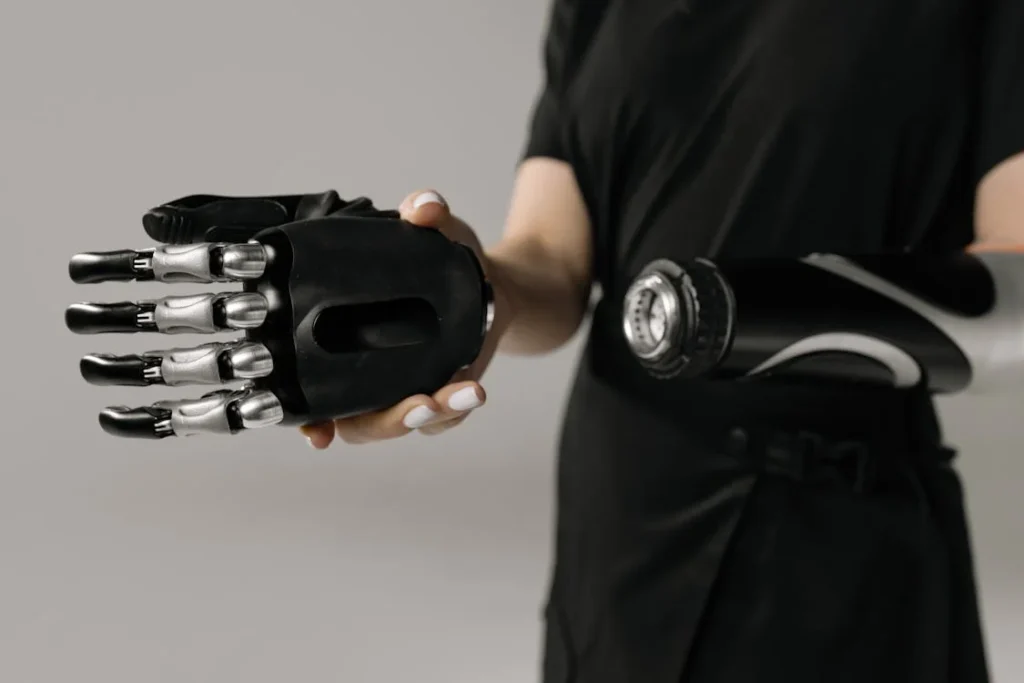
The Role of Technology in Making Gamified Prosthetic Therapy Possible
From Sensors to Software: How the System Works
Behind every engaging therapy game lies a combination of clever technology. These systems may look simple to a child—just a screen and some fun graphics—but the engineering working quietly in the background is sophisticated and deeply intentional. At the heart of gamified therapy is a connection between a prosthetic limb and a software platform.
Most modern pediatric prosthetics come equipped with sensors. These sensors can detect movement, pressure, speed, and even muscle signals. For example, when a child with a myoelectric arm contracts certain muscles in their residual limb, electrodes on the prosthetic pick up those signals. Those signals then tell the prosthetic what to do—open, close, rotate, grip, or release.
Now, imagine linking that same input to a game. When the child opens their hand, a character might jump. When they rotate their wrist, a spaceship may turn. The game acts as an interface that transforms physical movement into on-screen interaction. This direct connection helps the child understand how their body and their prosthesis are working together.
The software itself is just as important. It must respond quickly to movement, without delays or glitches. It must reward the right kind of actions and be adjustable for different skill levels. It also needs to track progress, store data, and help therapists monitor development over time. The best systems are designed to be both powerful and easy to use, making the experience smooth for kids, therapists, and families alike.
Adapting Gaming Technology for Medical Therapy
Interestingly, many of the tools used in gamified prosthetic therapy were first created for entertainment. Motion sensors, virtual reality headsets, game consoles—all of these started as toys or hobby devices. But when doctors and engineers saw how much they engaged people, especially children, they began exploring how to apply them to therapy.
One breakthrough came from motion capture cameras that track how the body moves. In games like virtual tennis or dance simulations, these cameras read arm and leg movement to control a character. When adapted for therapy, this same idea allows children to practice moving their prosthetic limbs in all directions while seeing the results immediately on screen.
Some systems use wearable sensors that can be strapped to the arm or leg, even before a child receives their prosthetic. These help with pre-prosthetic training, getting the brain used to sending signals and building muscle tone.
Other platforms use augmented reality or immersive 3D environments. A child might see their own body on the screen with their prosthetic moving just like it does in real life—but surrounded by a magical world where they’re flying through clouds or chasing treasure. This mix of real and imaginary not only keeps therapy fun but also helps the child build a positive emotional connection with their prosthetic limb.
What makes these technologies work so well in therapy isn’t just the tech itself—it’s how it’s used. Everything must be designed with a child’s brain, body, and heart in mind. It must support their learning, celebrate their effort, and invite them to keep playing even on hard days.
Why Mobile and Home-Based Options Are Expanding Access
For a long time, most therapy happened in clinics. Families had to travel, sometimes long distances, to attend appointments. This can be tiring, especially for young children or parents juggling work and caregiving. Gamified therapy is now breaking that mold.
Thanks to mobile apps and lightweight hardware, many therapy games can now be used at home. Some platforms use tablets, smartphones, or even home gaming consoles. Children can play short sessions every day—before school, after dinner, or even on weekends. These small doses of daily movement keep therapy consistent, which is one of the biggest factors in long-term success.
Home-based gamified therapy also gives parents a bigger role. They become active supporters in the process, encouraging their child, noticing small wins, and staying involved in the healing journey. For children who are shy or uncomfortable in clinics, doing therapy in the safety of home makes it feel less like treatment and more like playtime.
Even in remote areas, where access to advanced prosthetic clinics may be limited, gamified therapy tools can be delivered through digital downloads. Some companies are creating low-bandwidth versions that work even with slow internet connections. Others offer portable kits that include a tablet and sensors so everything is ready to go out of the box.
This kind of access is a big deal, especially in a country like India where geography, language, and infrastructure can make rehabilitation services hard to reach. At Robobionics, we’re working to expand these options so that children across urban and rural communities can benefit from smart, engaging therapy without delay.
Ensuring Safety and Monitoring Progress
With any therapy—especially one involving technology—safety is critical. Games must be designed to avoid overuse or strain. The goal is to challenge, not exhaust. Good gamified systems adjust the intensity based on how the child is responding. If a child is tired or struggling, the game can slow down or offer easier goals. If they’re making progress quickly, it can offer more advanced challenges.
Another important feature is data tracking. Each session produces information about how the child moved, how long they played, how accurate they were, and whether their skills are improving. This data can be shared securely with the therapist and used to fine-tune the treatment plan.
Even small changes—like slower reaction time or uneven movement—can be picked up early. That means therapists can address issues before they become problems. It also allows for setting realistic goals and celebrating achievements. Children can see how far they’ve come, not just by winning in a game, but through real metrics that show their growth.
Parents find this reassuring too. Instead of waiting for monthly reports, they can see day-by-day improvement. They can talk to their child’s therapist with clarity, share observations, and ask better questions. The therapy becomes a partnership between child, parent, and professional—with technology holding it all together.
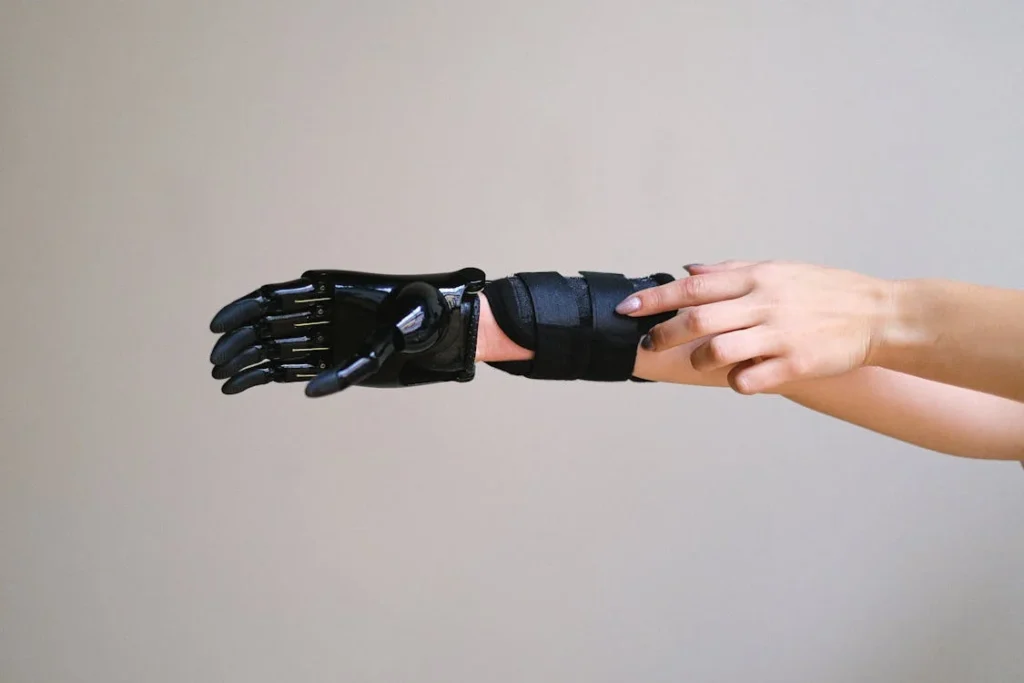
How Gamified Therapy Builds Long-Term Independence and Resilience
From Learning to Mastery: Turning Kids into Confident Users
The early stages of prosthetic use are all about learning—figuring out how the device works, building coordination, and getting used to movement. But as children grow and develop, the goal shifts from simply using their prosthetic to mastering it. This is where gamified therapy becomes more than just a support tool—it becomes a foundation for lifelong independence.
Once the child becomes familiar with their prosthetic limb through playful activities, they begin to understand its full capabilities. The same actions they practiced in therapy games—like gripping, rotating, or reaching—become useful in everyday life. Suddenly, opening a door, tying shoelaces, or holding a cup feels more natural. This real-world transition is one of the biggest goals in rehabilitation. When therapy is enjoyable and consistent, it creates physical and mental habits that make this transition smoother.
Gamified therapy also encourages curiosity. Instead of being afraid to try something new with their prosthetic, children who’ve had a positive therapy experience are more likely to experiment. They might want to build something with blocks, try drawing, or even explore music with their prosthetic limb. This kind of curiosity leads to mastery—not just technical control but a true sense of ownership.
It’s one thing to wear a prosthetic, and another to truly own it as part of who you are. Games that challenge, reward, and celebrate progress help children reach that point.
Reducing Therapy Dropout and Burnout in the Long Run
Traditional therapy programs for children often run into the problem of dropout. After a few weeks or months, motivation fades. The novelty wears off. Children get bored, tired, or frustrated, especially if they don’t see immediate results. And for busy families, keeping up with appointments or strict routines can be exhausting.
This is a serious issue because long-term success with prosthetics depends on continued practice and support. Without that, children may fall behind in skill development or even stop using their prosthetic altogether.
Gamified therapy reduces this risk significantly. Because the experience feels like play rather than work, children stay engaged for much longer. Games naturally include progression—new levels, harder tasks, visual rewards—that make therapy feel fresh. Even after months, there’s something new to achieve. That sense of constant progress keeps kids coming back.
For parents, this continuity is a gift. Instead of fighting to get their child to attend therapy, they often find themselves managing screen time because the child wants to do another session. That shift in attitude is one of the biggest wins of gamified therapy—it removes resistance and replaces it with excitement.
Over time, consistent engagement leads to better physical outcomes. Children who stick with therapy are more likely to have stronger muscles, better limb control, and fewer complications like poor posture or compensatory movements. Emotionally, they also benefit from a stronger sense of purpose and self-efficacy.
Supporting Growth through Every Stage of Development
Children aren’t static. Their bodies grow, their interests change, and their emotional needs evolve. A five-year-old who is just learning to use a prosthetic hand has very different challenges than a ten-year-old who’s trying to fit in at school or a teenager who’s developing a personal identity.
Gamified therapy grows with the child. The best platforms aren’t locked into one age group or stage—they evolve. Early levels may focus on basic limb movement, color recognition, or coordination. Later stages might involve more complex puzzles, social challenges, or competitive tasks. Some platforms even include multiplayer or collaborative games, allowing children to play alongside siblings, friends, or other kids with prosthetics. These social experiences are just as valuable as physical ones.
Teenagers especially benefit from more advanced, autonomy-focused therapy. They might use games that involve virtual sports, art, or even driving simulations. These help prepare them for adult tasks while still keeping the process fun and engaging.
At each step, the system adjusts. Therapists can switch the focus of the game, tweak the difficulty, or introduce new tools. That flexibility makes gamified therapy a long-term solution, not just a temporary fix.
Fostering Emotional Resilience and Mental Strength
The journey of living with a prosthetic isn’t just physical—it’s deeply emotional. Children may face teasing, questions, or even moments of sadness when they feel different from their peers. This emotional weight can affect how they engage with therapy, school, and social life.
Gamified therapy plays an unexpected but powerful role in building emotional resilience. When children succeed in therapy games, they feel competent. When they fail and try again, they learn persistence. When they beat a tough level after several tries, they learn to trust themselves.
These emotional lessons transfer to the real world. A child who learns to keep trying in a game may be more likely to keep trying at school, on the playground, or when faced with a difficult task. Over time, this builds grit—the ability to handle setbacks and keep moving forward.
Therapy games also allow safe exploration of identity. Children can see avatars that reflect their bodies. They can play roles that celebrate their uniqueness rather than hiding it. That sense of being seen, represented, and celebrated can make a big impact on self-worth.
In some cases, games also introduce mindfulness elements—calm breathing, gentle feedback, or positive affirmations. These small touches help children stay calm, reduce anxiety, and enjoy the experience more fully.
Even better, many children begin to see their prosthetic not as something that sets them apart, but as something that gives them an edge. In the game, their bionic arm is a tool for winning, creating, exploring. That perspective shift—from burden to superpower—is one of the most powerful outcomes of gamified therapy.
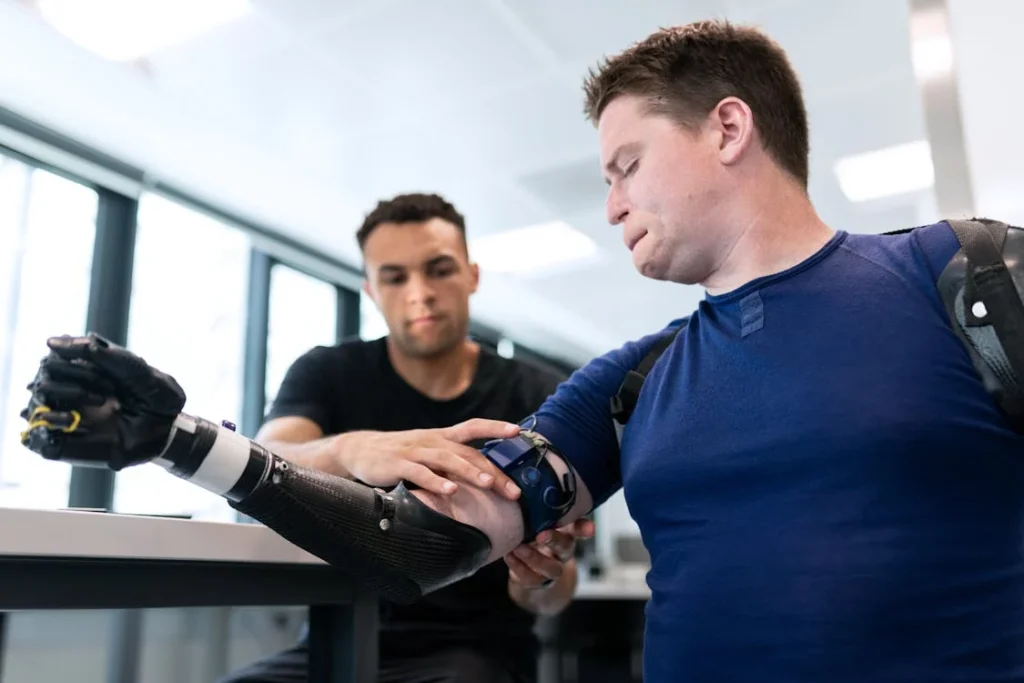
How Gamified Therapy Can Help Shape Future Prosthetic Design for Children
Turning Gameplay Data Into Better Devices
Every time a child uses their prosthetic in a game, they’re not just playing—they’re also generating valuable data. Every movement, every success, and every difficulty they face can be recorded by the system. When analyzed carefully, this data becomes a powerful tool that can influence how future pediatric prosthetics are built.
Most current prosthetic designs are made with general assumptions: a typical child’s hand span, expected strength levels, or common range of motion. But kids are wonderfully diverse, and so are their needs. Gamified therapy systems reveal those needs in ways that traditional therapy cannot.
For example, if a child repeatedly struggles with a specific type of wrist rotation in a game, that may point to a flaw or limitation in the prosthetic’s design—not the child’s ability. If hundreds of children across therapy platforms show the same pattern, prosthetic engineers get direct insight into what needs to be redesigned. Maybe the wrist needs to rotate more freely. Maybe the grip pattern needs more sensitivity. Maybe the shoulder socket needs to allow more comfort during upward motion.
This kind of user-generated insight helps shift prosthetics from generic to child-centric—something built around how kids actually move, play, and explore.
At Robobionics, we see gamified therapy as more than just recovery—it’s research in motion. It’s a way to listen to young users, not just through interviews or observations, but through real-time interaction. Every point earned, every virtual object grasped, every obstacle missed—these tell a story. And that story helps us build better devices.
Helping Engineers Understand Kids in a Natural Environment
It’s one thing to test a prosthetic in a clinic. A child sits still, the therapist watches, and movements are controlled. But that doesn’t reflect how a child truly behaves. Kids wiggle, stretch, jump, drop things, and run. And when they play a game, all those natural instincts come out.
That’s what makes gamified therapy such a goldmine for engineers and designers.
In the safety of a game, children behave more like themselves. They’re less self-conscious, more expressive, and more experimental. They’ll try weird moves just to see what happens. They’ll grip too tight, or too soft. They’ll find creative solutions that adults wouldn’t even think of.
All of this gives designers a window into real use—not imagined use.
And because the environment is digital, every interaction can be tracked without being invasive. The prosthetic’s reaction time, the angles used, the pressure applied—these can all be measured. This helps identify patterns like fatigue, delayed response, or awkward posture that would be missed in a short in-person session.
Armed with this information, prosthetics can be made lighter, stronger, or more intuitive—not just for clinical success, but for the messy, fast-paced world kids actually live in.
Inspiring New Types of Interfaces Through Play
Gamified therapy is also pushing the boundaries of how prosthetics are controlled.
Most bionic limbs today are operated using muscle signals or pressure sensors. But as children engage with therapy games, they reveal new ways of thinking about input.
For instance, some kids adapt quickly to EMG signals (electrical activity in muscles). Others find it easier to use movement from a different part of their body to control the prosthetic. By watching how kids naturally adapt in games, researchers can experiment with alternative inputs. Maybe foot tapping can trigger a grip. Maybe facial movements or voice can assist with switching modes. Play invites experimentation, and kids often discover control pathways that even researchers hadn’t considered.
Some games also explore eye tracking or brain-computer interfaces for future use. While still experimental, these innovations might one day give children even greater control—allowing them to use prosthetics with minimal physical effort, just by thinking or looking.
That level of intuitiveness is the future of prosthetic design—and gamified therapy is helping us get there faster.
Creating a Feedback Loop Between Kids, Games, and Technology
The most exciting part of this evolution is that it creates a continuous loop. Children use a prosthetic in a game. Their performance generates data. That data informs better prosthetic design. New prosthetics are created and tested—again through games. Each cycle leads to smarter, more customized, and more effective devices.
Gamified therapy doesn’t just help the child adapt to the prosthetic—it helps the prosthetic evolve to match the child.
And as this loop continues, we get closer to a future where pediatric prosthetics aren’t just downsized versions of adult ones. They’re dynamic, intelligent, kid-powered tools—built by watching children be children.
At Robobionics, this is exactly the vision we’re investing in: using play not only as a path to recovery but as a roadmap to innovation.
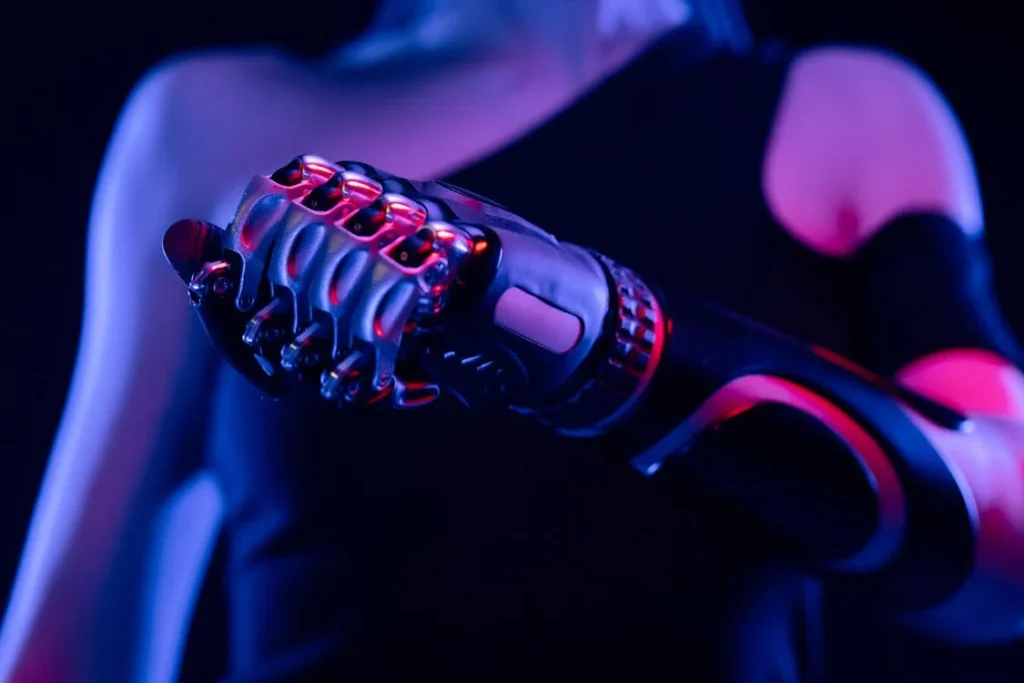
Integrating Gamified Therapy in Schools: Creating Inclusive Learning Environments
Why Schools Are the Missing Link in Pediatric Prosthetic Support
For many children, school is where they spend the majority of their time outside the home. It’s where they learn, make friends, and develop independence. But for a child with a prosthetic, school can also be a place filled with challenges. From navigating stairs and opening lunchboxes to participating in sports or group activities, each task can present physical or emotional hurdles.
Despite this, most schools are not actively involved in the child’s rehabilitation journey. Therapy happens at clinics. Adjustments are made at home. Meanwhile, teachers and classmates often don’t know how to support—or even talk about—what the child is experiencing.
Gamified therapy offers an opportunity to change this dynamic.
By introducing therapy-based games into the school setting, educators can help children continue their rehabilitation throughout the day in a way that feels natural and fun. It becomes part of their learning environment—not something separate or hidden. More importantly, it helps normalize prosthetic use for the entire classroom, promoting empathy, inclusion, and curiosity rather than isolation or pity.
Schools are the perfect setting for this shift because they are already built around structure, routine, and social interaction—key ingredients for successful therapy.
Blending Therapy into the School Day Without Disruption
One of the greatest strengths of gamified therapy is its flexibility. It doesn’t need an hour-long session or a hospital setting. In many cases, just 10 to 15 minutes a day is enough to make meaningful progress. This opens the door for schools to integrate short sessions into regular schedules—during breaks, free periods, or even as part of physical education or computer lab time.
A student could play a custom therapy game after completing classwork or during a supervised break. This reduces the need to miss school for appointments and lightens the burden on families. It also ensures that the child doesn’t fall behind academically while keeping up with physical rehabilitation.
Because the therapy feels like a game, other students often show interest too. In some classrooms, teachers allow everyone to take turns with the game—but adjust the settings so only the prosthetic user receives the targeted therapy benefits. This subtle approach reduces stigma. Instead of feeling like the “different” one, the child with the prosthetic becomes the one with the cool tech—the one who gets to “pilot the robot” or “train the space explorer.”
That kind of social framing builds confidence and can completely reshape a child’s self-image.
Training Educators and Support Staff for Collaborative Therapy
For gamified therapy to succeed in schools, teachers and staff need to be more than just observers. They should be collaborators. But that means they need support and training—not just in how to run the games, but in how to understand what the therapy is doing and why it matters.
This doesn’t require turning teachers into therapists. Instead, schools can partner with prosthetists or therapy centers to hold short workshops. These sessions can teach educators how to set up equipment, recognize signs of fatigue, and celebrate therapy milestones with the child.
More importantly, it empowers them to become emotional allies. When a child struggles with a game or has a tough day with their prosthetic, a trained teacher can offer understanding and encouragement. They can reframe setbacks in the same language the game uses: “Let’s try again—maybe today’s just a tricky level.” These small moments of empathy have lasting impact.
Support staff like counselors, librarians, and even physical education coaches can also play a role. The more adults who are aware of the child’s goals, the easier it is to create an environment where progress is supported at every step.
Transforming School Culture Through Technology and Inclusion
When a school embraces gamified prosthetic therapy, it sends a powerful message: differences are not deficits—they’re opportunities for innovation and growth. Technology becomes the bridge that connects medical needs with educational goals.
Some schools go further and include prosthetic education in science or health classes. Students learn how prosthetics work, how the human body adapts, and how games are used to train the brain. This opens up discussions about disability, engineering, and empathy in a way that feels exciting rather than heavy. It also inspires curiosity in fields like biomedical engineering, rehabilitation science, and inclusive design.
In classrooms where this kind of exposure happens, the culture changes. Children grow up seeing prosthetics not as something strange or sad, but as part of everyday life—just another form of human expression.
And for the child with the prosthetic, that shift is everything.
Instead of having to explain, defend, or hide their difference, they’re surrounded by peers who understand. Who cheer them on during therapy games. Who ask about new updates to their bionic arm like it’s a new gadget. Who admire their progress.
This environment helps reduce the emotional isolation that some prosthetic users face. It builds resilience not through solitary strength, but through belonging.
Conclusion
Gamified therapy is more than just a fun twist on rehabilitation—it’s a revolution in how we care for children with prosthetics. By turning recovery into an interactive, rewarding experience, we unlock motivation, speed up skill-building, and make therapy something kids look forward to—not dread. Whether it’s helping a child master their first grip, boosting their confidence at school, or shaping the next generation of prosthetic design, games are proving to be powerful allies.
At Robobionics, we believe healing should be joyful, progress should be visible, and no child should feel left behind just because therapy is hard. With gamified therapy, children aren’t just learning how to use their prosthetics—they’re discovering their strength, their courage, and their potential to thrive.
In the end, it’s not just about winning in a game. It’s about winning in life. And with every playful push, every virtual challenge, and every high-five from a game character, these kids are taking real steps toward a future filled with independence and confidence—one move at a time.



